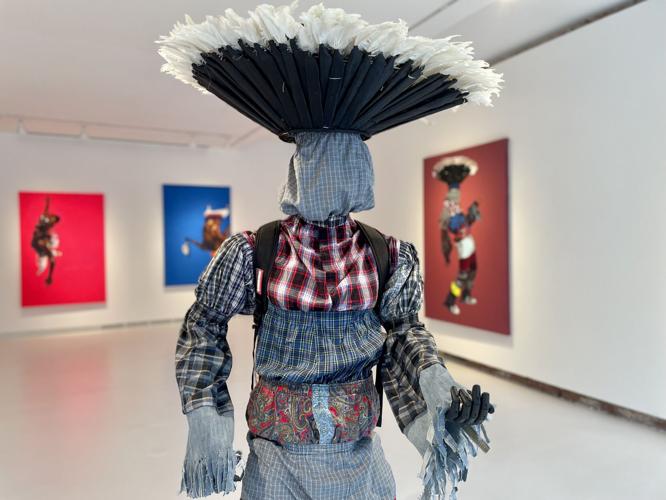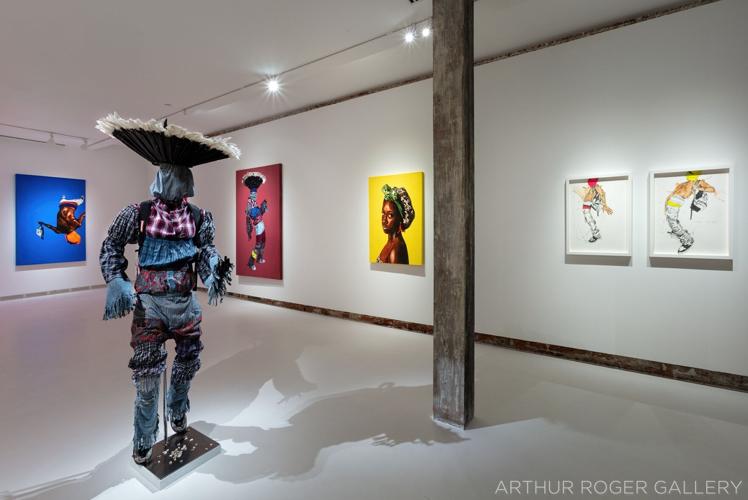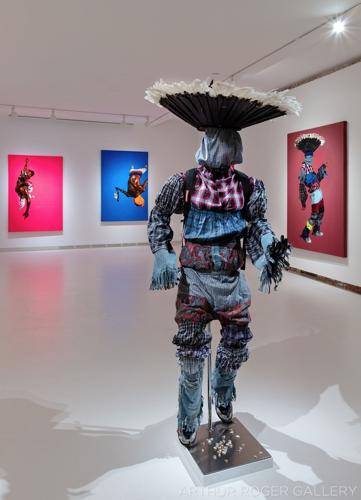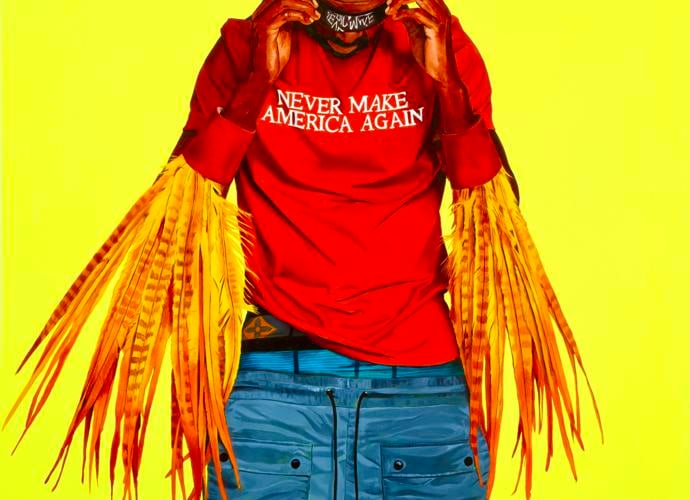Atlanta artist Fahamu Pecou has taken sagging to its illogical extreme in his exhibit of paintings and costuming at Arthur Roger Gallery.
Everyone’s seen sagging. It’s the hip-hop-era style in which oversized pants hang precariously low on the hips, exposing a strip of underwear above.
In the center of the Julia Street gallery stands a mannequin wearing a segmented suit made by Pecou, in which layers of sagging climb from bottom to top like a plaid and paisley totem pole. The sculptural costume is called “Sag God.”
The frayed denim pants legs that cover the mannequin’s calves sag beneath pairs of underwear, which sag beneath other pairs of underwear, which sag beneath others, past the knees, past the waist, past the neck, all the way to the scalp.

'Sag God,' a mixed-media costume sculpture by Atlanta artist Fahamu Pecou, takes sagging style to its illogical extreme.
In a phone conversation in April, Pecou said some people have always presumed that sagging is associated with certain perceived stigmas. The style supposedly originated with (beltless) prison clothing, or maybe it had something to do with gay attire.
Not to mention that for years and years, it was the uniform of renegade rappers everywhere.
According to an article in The Guardian newspaper, the outraged town fathers of Delcambre, which straddles Iberia and Vermilion parishes, outlawed sagging in 2007 as a form of indecent exposure. Fines for exhibiting one’s Fruit of the Looms in public could run as high as $500.
Outrage may have always been the goal. Pecou said sagging is a form of what you call “oppositional fashion.” It was a way for young people, particularly young Black men, to “give a middle finger to society,” Pecou said, without even taking their hands out of their pockets.
The establishment saw sagging as an affront, of course. Which made the style all the more necessary. Pecou said that, for many, sagging may have been “a first step in eking out autonomy and agency.”
To wear baggy jeans and plaid boxers can be seen as “a performance exercise in moving away from what society sees as appropriate.”
To emphasize the point, Pecou topped his “Sag God” with a cone-shaped feather headdress worn in masquerade performances in Cameroon. The figure wears a transparent vinyl backpack loaded with hundreds of ceremonial cowry shells. A YouTube video shows the “Sag God” in action, distributing the magical shells.
This short film accompanies an exhibit of paintings and drawings by the same title. These works are in conversation with ideas of hope and aspiration rarely considered on Black bodies. This series transposes the typically negative associations made of Black youthful dissidence into an examination of what is possible when we seek an alternative perspective.
"If Heaven Had Heights" invites us to imagine heaven of our own making.
#fahamupecou #fahamupecouistheshit #worldwideheknownforthat #ifheavenhadheights
Pecou sees his whole art practice as a sort of performance. He said he personally poses for the hundreds of photos that he uses as models for most of his lushly colored, realistic paintings, which often feature figures dreamily flying through space.
The Air Jordan sneakers that appear in many of his works are like sagging, in a way. But instead of rebellion, they are a fashion accessory meant to symbolize aspiration and ambition among young Black men and others. To Pecou, the coveted shoes represent an effort “to elevate above where you are,” he said.

'Spaceships Don't Come With Rearview Mirrors,' by Atlanta artist Fahamu Pecou
Maybe to elevate all the way to heaven, allegorically speaking anyway. The title of the show, “If Heaven Had Heights,” is based on an admiring lyric in the love song “The Light,” by the rapper Common. “If Heaven had a height, you would be that tall,” he sings to a woman he adores.
Pecou’s art has appeared in galleries and museums across the country. But no audience will understand it better than New Orleanians, who are annually immersed in the masking and performance of Carnival, and all the symbolism, transformation and illogical extremes it allows.
The exhibit continues through June 17, at Arthur Roger Gallery, 432 Julia St. Pecou’s paintings range from $8,000 to $35,000. The price of the “Sag God” is available upon request at the gallery.
For his show, “Gabinetto Segreto,” artist Mitchell Gaudet was inspired by a “secret cabinet” of Roman erotic art found in the ashes of Pompeii that is housed in an Italian museum. Old Italian art is what sparked Gaudet’s exhibit in the first place.
A mural by the world’s most famous living artist has popped up in the Habana Outpost, an Esplanade Avenue restaurant, where it’s protected by …
Mardi Gras Indians — as the Black maskers are often known — don't bow down. Not to rival tribes, not to the storms, floods and evacuations tha…










